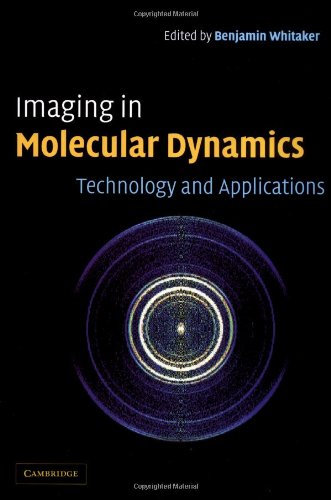Benjamin J. Whitaker0521810590, 9780521810593, 9780511064272
Table of contents :
Half-title……Page 3
Title……Page 5
Copyright……Page 6
Contents……Page 7
Contributors……Page 11
Preface and acknowledgements……Page 13
Abbreviations……Page 17
Part One Technology……Page 19
1.1 Introduction……Page 21
1.2 The need for angular information: vector correlations……Page 22
1.3 The Doppler effect……Page 24
1.4 The ESDIAD inspiration……Page 28
1.5 Product imaging……Page 29
1.6 Electron imaging……Page 32
1.7 Coincidence measurements……Page 33
References……Page 34
2.1.1 Outline of this chapter……Page 38
2.2 Newton spheres: their concept, creation and analysis……Page 39
2.2.1 Ideal conditions for creating Newton spheres……Page 40
2.2.3 Why is the surface pattern anisotropic?……Page 41
2.2.5 Bimolecular scattering……Page 43
2.2.6.2 Vector notation……Page 45
2.2.7 Three-vector correlations……Page 46
2.3.1 Detection of reaction products by ionization……Page 49
2.3.2 All for one, or one for all?……Page 51
2.3.3 Event time zero……Page 52
2.3.5 Determination of product internal energy and velocity……Page 53
2.3.6 Flux versus density detection……Page 54
2.3.6.3 Production by bimolecular scattering……Page 55
2.3.7 Time of ionization and types of ionizers……Page 56
2.4 Velocity map imaging of photodissociation……Page 58
2.4.1 The beta parameter……Page 59
2.4.2 The velocity map imaging experiment……Page 61
2.4.3.2 The dissociation laser and the molecule – photon interaction……Page 63
2.4.4.2 Ion recoil from REMPI……Page 64
2.4.4.4 Flux-density transformation……Page 68
2.4.5.1 Detection geometry……Page 69
2.4.5.2 Ion optics……Page 70
2.4.5.3 Space charge……Page 73
2.4.5.5 Imaging detectors……Page 74
2.4.5.6 Time gating of the imaging detector……Page 76
2.4.5.7 Event counting……Page 77
2.4.6.1 Avoiding the crush – slicing methods in imaging……Page 79
2.5 The easy experiment……Page 80
References……Page 82
3.1 Introduction……Page 83
3.2 Symmetric distributions……Page 84
3.3 Abel and Hankel inversion methods……Page 86
3.4 Back-projection and onion peeling methods……Page 89
3.4.1 The onion peeling algorithm……Page 94
3.5 Iterative inversion……Page 95
3.6 Basis set expansion or BASEX method……Page 97
3.7.1 Algorithms……Page 100
3.7.2 Test criteria and comparison method……Page 102
3.8.1 Clean images……Page 104
3.8.2 Influence of noise……Page 110
3.8.3 Influence of distortion……Page 114
3.8.4 Reconstruction accuracy in numbers……Page 115
3.8.5 Experimental images……Page 119
3.8.6 Test conclusion……Page 121
3.9 Forward convolution……Page 124
3.10 Conclusions and outlook……Page 127
3.11.1 Speed and radial distribution……Page 128
Acknowledgements……Page 129
References……Page 130
4.1 Introduction……Page 131
4.2 Formalism……Page 132
4.3.1 Axial recoil of diatomic molecules……Page 135
4.3.2 Non-linear molecules……Page 136
4.3.3 Finite lifetime of dissociation……Page 137
References……Page 138
5.1 Introduction……Page 140
5.2 3-D imaging scheme……Page 141
5.3 Experimental setup……Page 146
5.4 Detector time calibration……Page 147
5.5 Multi-particle detection……Page 150
5.6 Summary……Page 153
References……Page 154
6.1 Introduction……Page 156
6.1.1 Why 3-D imaging?……Page 157
6.2.1 Optical system……Page 158
6.2.2 Molecular beam……Page 159
6.2.4 Delay-line position-sensitive detector……Page 160
6.2.5 DLD data analysis……Page 161
6.2.7 Why DLD?……Page 162
6.3.1 Speed and temperatures of the molecular beam……Page 163
6.3.2 Spectroscopy of cold molecules……Page 167
6.4.1 Experimental results……Page 168
6.4.2 Spatial fragment anisotropy – how to calculate the β parameter……Page 171
6.5.1 Atomic photofragment alignment……Page 173
6.5.3 Angular distribution of photofragments:‘ core-sampling’ technique……Page 175
6.5.4 Application of 3-D detection to the photolysis of COCl……Page 176
6.5.5 Photolysis of SOCl: 3-D detection of Cl atoms……Page 179
6.6 The road ahead and concluding remarks……Page 180
References……Page 181
7.2 Femtosecond lasers……Page 183
7.3 Time resolved photoelectron imaging: a new probe of femtochemistry……Page 189
7.3.1 Examples of time-resolved photoelectron imaging……Page 192
7.3.2 Time-resolved photoelectron photoion coincidence imaging……Page 199
7.4 Time-resolved photoion imaging……Page 200
7.5 Conclusions……Page 202
References……Page 203
Part Two Applications……Page 205
8.1 Introduction……Page 207
8.2.1 Fast beam and laser excitation……Page 209
8.2.3 Multi-hit methods and readout system……Page 210
8.3 The H molecule……Page 213
8.4 Imaging two-body decay processes……Page 215
8.5 Imaging three-body decay processes……Page 218
8.6 Presentation of high-dimensional imaging data……Page 220
8.7 Discussion of experimental data……Page 221
Acknowledgements……Page 223
References……Page 224
9.1 Introduction……Page 226
9.2 Experimental……Page 228
9.3 Comparison of images of HCl + molecular colliders with HCl + Ar images……Page 229
9.4 Differential cross-sections from ion images of………Page 230
9.5 Extracting DCSs from HCl………Page 232
References……Page 234
10.1 Introduction……Page 235
10.2 Experimental……Page 237
10.3 Results and discussion……Page 238
10.4 Conclusions……Page 243
References……Page 244
11.1 Introduction……Page 245
11.2.1 Kinematics of a single uniform acceleration field……Page 246
11.2.2 Conventional versus pulsed extraction (slice imaging)……Page 248
11.3.1 Ion optics……Page 250
11.3.2 Repeller high voltage switch……Page 251
11.4 Results……Page 253
11.4.2 Conventional velocity mapping versus slice imaging……Page 255
11.4.3 Extracting angular distributions from slice images……Page 259
11.4.4 Extracting speed distributions from slice images……Page 260
11.5 Conclusions……Page 261
References……Page 262
Index……Page 265

Reviews
There are no reviews yet.